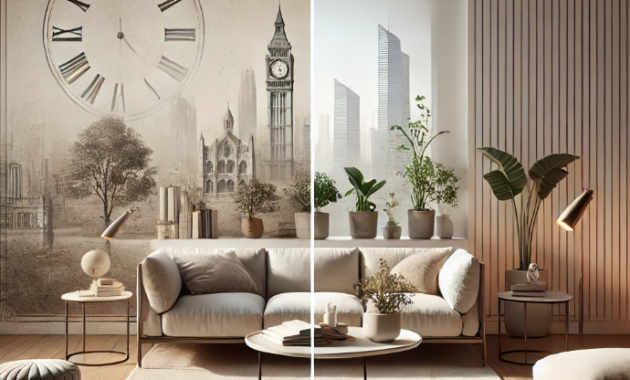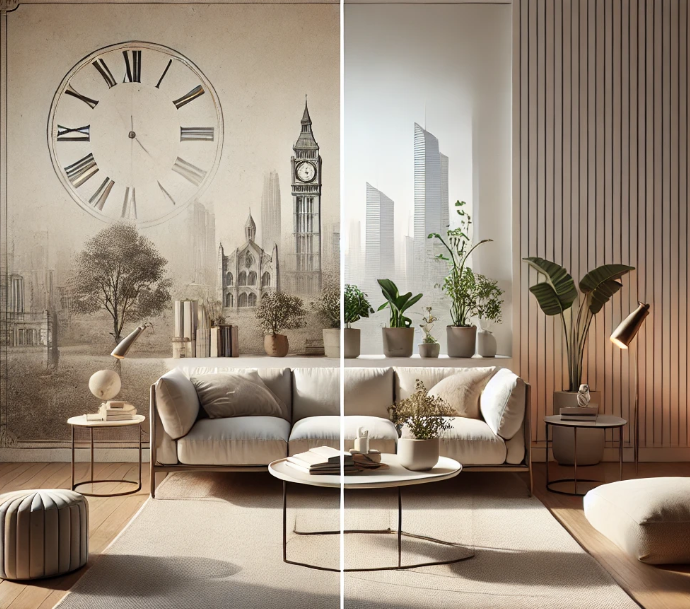
Minimalism is more than just an aesthetic; it’s a lifestyle choice that brings peace, organization, and simplicity into your home. A minimalist living room doesn’t just look good – it feels good too. If you’re considering a transformation, here’s how you can create a serene, clutter-free environment that feels spacious and relaxing.
What is Minimalist Interior Design?
Minimalist interior design focuses on simplicity, functionality, and clean lines. The idea is to strip away the excess and only keep the essentials. Originating in the 20th century as part of the modernist movement, minimalist design emphasizes open spaces, neutral colors, and the beauty of simple forms. It’s a design that invites you to focus on quality over quantity.
Why Choose Minimalist Design for Your Living Room?
Choosing minimalist design for your living room offers several benefits. First and foremost, it creates a calming atmosphere by eliminating unnecessary distractions. Minimalism makes a room feel more spacious, even if the square footage is small. Additionally, a minimalist space is easier to maintain, as there’s less clutter to clean and organize. It can promote mindfulness and a sense of peace – an essential feature for a space designed for relaxation.
Decluttering: The First Step
The first and most important step in creating a minimalist living room is decluttering. A minimalist space thrives on open, clean surfaces with only the essentials. Start by removing items you don’t need or use. If something doesn’t serve a functional or aesthetic purpose, it doesn’t belong in your minimalist design.
Tips for Effective Decluttering:
- Sort through each item and ask yourself, “Does this add value to the space?”
- Donate or sell items that are still in good condition.
- Keep only the items that have both practical and emotional value.
Choosing a Neutral Color Palette
Neutral colors are the backbone of minimalist design. Shades like white, gray, beige, and black allow other elements in the room to stand out. They create a tranquil environment and make the space feel larger. A neutral palette also offers flexibility when it comes to styling – you can add small pops of color through art or accessories.
Popular Color Schemes and Their Effects:
- White and soft grays: Brightens the space and makes it feel open and airy.
- Beige and taupe: Adds warmth while maintaining a clean look.
- Black accents: Adds sophistication and contrast without overwhelming the space.
Furniture Selection for a Minimalist Living Room
When selecting furniture for a minimalist living room, the goal is functionality and simplicity. Choose pieces that are streamlined, elegant, and practical. Look for furniture that serves multiple purposes, such as a sofa with storage underneath or a coffee table that doubles as a workspace.
Embracing Simplicity in Furniture
In a minimalist living room, “less is more.” Instead of filling the room with bulky furniture, choose fewer, well-designed pieces that offer both form and function. For instance, opt for a simple, low-profile sofa with clean lines. Consider materials like wood, metal, and glass, which are both functional and aesthetically pleasing.
Examples of Minimalist Furniture Pieces:
- A sleek, minimalist sectional sofa in neutral tones.
- A glass coffee table with minimal ornamentation.
- Simple, low-profile bookshelves or wall-mounted storage units.
Lighting and Natural Elements
Lighting plays a crucial role in minimalist design. Natural light, in particular, is a vital component of any minimalist space. It opens up the room, makes it feel airy, and highlights the clean lines and neutral tones. Where possible, allow natural light to flood the room by using sheer curtains or blinds that can be easily opened.
Incorporating plants or natural textures also adds life to the room without overwhelming the minimalist aesthetic. A few well-placed indoor plants can create a sense of calm and connection to nature, which complements the minimalist design.
Flooring and Textiles in Minimalist Design
The choice of flooring is also critical in minimalist design. Hardwood, bamboo, or polished concrete floors work beautifully with minimalist interiors. They offer a clean, modern look and complement the neutral tones often found in minimalist spaces.
When it comes to textiles, keep things simple. Opt for high-quality fabrics in neutral colors. Throw blankets, rugs, and cushions should be few but comfortable and tactile. Choose solid colors or simple geometric patterns to maintain a calm, cohesive look.
Storage Solutions for a Clutter-Free Living Room
Minimalism is all about reducing clutter, and smart storage solutions are key. Invest in furniture that serves dual purposes, like an ottoman with hidden storage or a media console with compartments for keeping items out of sight.
Creative Ways to Store Belongings:
- Use floating shelves or wall-mounted cabinets to keep the floor space clear.
- Opt for built-in storage solutions to maximize space without adding visual clutter.
- Keep everyday items organized with decorative baskets or storage bins.
Adding Personality to a Minimalist Living Room
One common misconception about minimalism is that it has to feel sterile or lacking in personality. This isn’t true! Minimalism can still reflect your style – it’s all about balance. Use artwork, a few select accessories, or a standout furniture piece to add character without cluttering the room.
Minimalist Art and Decor Tips:
- Choose one or two statement art pieces that evoke emotion and reflect your personality.
- Incorporate simple sculptures or handcrafted decor items made from natural materials.
Creating Balance with Symmetry
Minimalism thrives on balance and symmetry. The arrangement of furniture and decor should feel harmonious and evenly distributed throughout the room. Symmetry can be achieved through the placement of furniture or the use of identical decor pieces on either side of the room.
How to Achieve Symmetry:
- Place a matching pair of chairs or lamps on either side of a sofa.
- Use identical frames for wall art or mirrors.
Maintenance and Long-Term Sustainability
A minimalist living room isn’t just about creating a stylish space – it’s about maintaining it in the long term. Regular cleaning and organization will help you keep your space serene and clutter-free.
Sustainable Choices in Furniture and Decor:
- Choose timeless, durable furniture that won’t go out of style.
- Invest in quality items that are built to last, rather than fast fashion furniture pieces.
Conclusion
Transforming your living room with minimalist interior design can bring a sense of peace, balance, and order into your home. By focusing on simplicity, neutral tones, and functional furniture, you create a space that is not only visually pleasing but also calming. Remember to declutter, use natural elements, and choose versatile pieces that reflect your personality while maintaining the minimalist ethos. In the end, less truly can be more – creating a space that’s both beautiful and functional.
FAQs
- How can I start creating a minimalist living room with a small budget?
Start by decluttering and focusing on quality over quantity. Invest in key furniture pieces like a neutral sofa or simple coffee table. You don’t need to buy everything at once – a minimalist space can evolve over time. - What are the best colors for a minimalist living room?
Neutral tones like whites, grays, and beige are the foundation of minimalist design. You can add pops of color with art or accent pieces, but the overall palette should be calming and understated. - Is it necessary to remove all personal items for a minimalist design?
No, personal items can be included in a minimalist design as long as they contribute to the overall aesthetic. The key is to avoid excess and keep only items that have purpose and meaning. - Can minimalist design work in a small living room?
Absolutely! In fact, minimalist design is perfect for small spaces as it helps maximize the feeling of openness and allows for better flow and functionality. - How do I incorporate technology into a minimalist living room?
Choose sleek, unobtrusive tech devices. Opt for wall-mounted TVs, hidden sound systems, and other compact devices that blend seamlessly into the room’s design without disrupting the minimalist aesthetic.
Read More

Leave a Reply